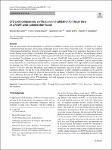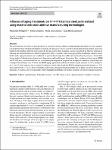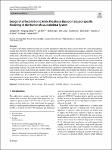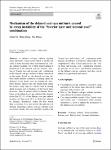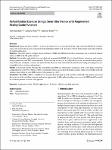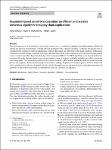Search
Author
- Amir, Ebrahimi (2)
- Aydin, Azizi (2)
- George, Haller (2)
- James, M. Fiore (2)
- next >
Subject
- robotics (9)
- Engineering (8)
- engineering (8)
- công nghệ (3)
- next >
Date issued
- 2020 - 2023 (215)
- 2010 - 2019 (28)
- 2001 - 2009 (6)
Has File(s)
- true (249)
Search Results
With the advancement of high-performance computation capabilities in recent years, high-fidelity modelling tools such as computational fluid dynamics are becoming increasingly popular in the offshore renewable sector. To justify the credibility of the numerical simulations, thorough verification and validation is essential. In this work, preparatory heave decay tests for a freely floating single cylinder are modelled. Subsequently, the surge and sway decays of a linearly moored floating offshore wind turbine model of the OC4 (Offshore Code Comparison Collaboration Continuation) phase II semi-submersible platform are simulated. Two different viscous-flow CFD codes are used: OpenFOAM (open-source), and ReFRESCO (community-based open-usage). |
The most relevant criticalities of parts produced by material extrusion additive manufacturing technologies are lower mechanical properties than standard material performances, the presence of pores caused by the manufacturing method, and issues related to the interface between layers and rods. In this context, heat treatments can be considered an effective solution for tailoring the material behavior to different application fields, especially when using precipitation hardening stainless steels. In this work, aging treatments were conducted on parts realized using three different extrusion-based processes: Atomic Diffusion Additive Manufacturing, bound metal deposition, and fused filament fabrication. |
A variety of prosthetic ankles have been successfully developed to reproduce the locomotor ability for lower limb amputees in daily lives. However, they have not been shown to sufficiently improve the natural gait mechanics commonly observed in comparison to the able-bodied, perhaps due to over-simplified designs of functional musculoskeletal structures in prostheses. In this study, a flexible bionic ankle prosthesis with joints covered by soft material inclusions is developed on the basis of the human musculoskeletal system. First, the healthy side ankle–foot bones of a below-knee amputee were reconstructed by CT imaging. |
A delayed coal–gas outburst incident often represents a more severe threat to health and safety of mine personnel than an instantaneous coal–gas outburst incident. For a better understanding of mechanism of the delayed coal–gas outburst, structure of “barrier layer and tectonic coal” combination in the delayed coal–gas outburst is firstly introduced in this paper. Based on, the delayed coal–gas outburst under different conditions of mining depth and thickness of the barrier layer are numerically simulated. Results indicate that the barrier layer enters the tertiary creep stage in a shorter time as mining depth increases and as thickness of the barrier layer decreases. Then we analyze effect of dynamic disturbance on the delayed coal–gas outburst. |
Smart-bar device (SBD) is a newly developed device to measure the body range of motion (ROM) by a kinetic sensor and to provide an exercise program with augmented reality (AR) guidance of body-frame image and audio feedback by mobile application. |
Dynamical systems are often subject to algebraic constraints in conjunction with their governing ordinary differential equations. In particular, multibody systems are commonly subject to configuration constraints that define kinematic compatibility between the motion of different bodies. A full-scale numerical simulation of such constrained problems is challenging, making reduced-order models (ROMs) of paramount importance. In this work, we show how to use spectral submanifolds (SSMs) to construct rigorous ROMs for mechanical systems with configuration constraints. These SSM-based ROMs enable the direct extraction of backbone curves and forced response curves and facilitate efficient bifurcation analysis. We demonstrate the effectiveness of this SSM-based reduction procedure on seve... |
The growing interest in blockchain technology has gained a lot of attention in Supply Chain Management (SCM) and sparked the quest for decentralized, scalable, efficient and trustworthy consensus schemes. Traditional blockchains rely on computationally expensive consensus mechanisms with low throughput and high latency. This paper conducts a performance evaluation of several existing consensus protocols to illustrate blockchain’s shortcomings in terms of consensus and propose a new consensus algorithm: Reputation based proof of cooperation (RPoC). The RPoC algorithm uses a layered architecture to segment the nodes that participate in the consensus phase in order to improve scalability and efficiency while maintaining trust among peers. |
The soft robotics field is on the rise. The highly adaptive robots provide the opportunity to bridge the gap between machines and people. However, their elastomeric nature poses significant challenges to the perception, control, and signal processing. Hydrogels and machine learning provide promising solutions to the problems above. This review aims to summarize this recent trend by first assessing the current hydrogel-based sensing and actuation methods applied to soft robots. We outlined the mechanisms of perception in response to various external stimuli. Next, recent achievements of machine learning for soft robots’ sensing data processing and optimization are evaluated. Here we list the strategies for implementing machine learning models from the perspective of applications. Las... |
EBUNet: a fast and accurate semantic segmentation network with lightweight efficient bottleneck unit It has been difficult to achieve a suitable balance between effectiveness and efficiency in lightweight semantic segmentation networks in recent years. The goal of this work is to present an efficient and reliable semantic segmentation method called EBUNet, which is aimed at achieving a favorable trade-off between inference speed and prediction accuracy. Initially, we develop an Efficient Bottleneck Unit (EBU) that employs depth-wise convolution and depth-wise dilated convolution to obtain adequate features with moderate computation costs. Then, we developed a novel Image Partition Attention Module (IPAM), which divides feature maps into subregions and generates attention weights based on them. As a third step, we developed a novel lightweight attention decoder with which to retriev... |
Seizure prediction algorithms have been central in the field of data analysis for the improvement of epileptic patients’ lives. The most recent advancements of which include the use of deep neural networks to present an optimized, accurate seizure prediction system. This work puts forth deep learning methods to automate the process of epileptic seizure detection with electroencephalogram (EEG) signals as input; both a patient-specific and general approach are followed. EEG signals are time structure series motivating the use of sequence algorithms such as temporal convolutional neural networks (TCNNs), and long short-term memory networks. We then compare this methodology to other prior pre-implemented structures, including our previous work for seizure prediction using machine learn... |

